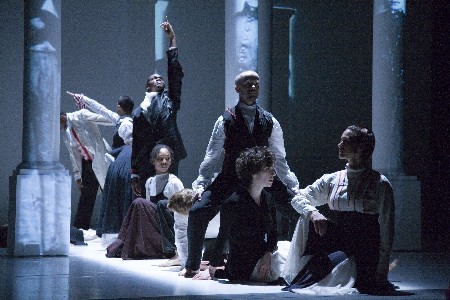Judicial Review Preview: Bill T. Jones’ American Pillars
In Serenade/The Proposition, the first of Bill T. Jones’ investigations into the myth and legacy of Abraham Lincoln, the choreographer looks at history and history looks back.

Serenade/The Proposition: (Front to Back) Maija Garcia; Asli Bulbul; Peter Chamberlin; Paul Matteson; Shayla-Vie Jenkins; Antonio Brown; Erick Montes; LaMichael Leonard Photo: Paul B. Goode
By Debra Cash
Cash was the professional critic on the Judicial Review panel reacting to Bill T. Jones’ Serenade/The Proposition at Jacob’s Pillow, July 21 through 25. She was joined by Professor Nina Silber of Boston University, a Lincoln scholar, and Miriam Ornstein, a Boston-area child psychiatrist.
The six Doric columns Bjorn Amelan designed for his partner Bill T. Jones’ Serenade/The Proposition convey order while they imply division. Rational, steady, holding up a roof of air and then a video portico, they echo the entrances to both Greek temples and plantations, the political gestures of the Lincoln Memorial, the White House and even the much-maligned stage set at Ivesco Field in Denver where Barack Obama accepted the Democratic nomination for President.
The columns frame, separate and shape the work’s dance action; projected with heroic figures, they display ancestors larger than life; painted with video flames, they burn like Confederate Richmond. These columns are simultaneously the pillars of our country and blank markers for our contemporary, unsettled circumstances.
Serenade/The Proposition was the first of Bill T. Jones’ investigations into the myth and legacy of Abraham Lincoln. Choreographed in 2008, it was presented on the Bill T. Jones/Arnie Zane Dance Company’s 25th anniversary season and was the first of a series of commissions marking the bicentennial of Lincoln’s birth. This summer it is being presented in a high-profile engagement at the Jacob’s Pillow Dance Festival in the Berkshires (the Pillow awarded Jones its fourth annual award as an “outstanding visionary artist” this past June, a prize that carries $25,000, the largest cash award in American dance. The festival is also hosting a display of photographs by Jones’ late partner, company cofounder Arnie Zane, in the lobby of the Ted Shawn Theatre).
A week later, Berkshire audiences saw a single performance of Jones’ fuller, elaborated Lincoln-themed piece, Fondly Do We Hope… Fervently Do We Pray (2009) across the New York border at the Saratoga Performing Arts Center in Saratoga Springs.
Barring a trip to the Berkshires, a national audience will be exposed to these works when A Good Man, a feature length documentary about Jones’ Lincoln choreographies by the Chicago-based Kartemquin Films, is broadcast in PBS’ American Masters series in 2011. Chalk it up to popular interest in the topic or to the fact that Jones is perhaps one of the most articulate artists working in any discipline, but especially given dance’s ephemeral nature, these turn-of-the-21st-century Lincoln portraits are being more fully documented than any dance activities in recent memory.
Jones, the son of migrant workers and great-grandson of slaves who now has a MacArthur “genius” grant and two Tony Awards to his name, has been quoted as saying that as a child, Abraham Lincoln was the one white man he could love unreservedly. In school, he learned the Gettysburg Address by heart; as a boy, his family took a road trip passing sites of the Civil War; during the 1950s and 1960s and the Civil Rights struggle, he accepted the schoolboy vision of Abraham Lincoln as Great Emancipator.

Serenade/The Proposition: Erick Montes Photo: Paul B. Goode
Yet Jones’ mature take on Lincoln began as witness for the prosecution. Was Lincoln a racist, a pragmatist, an opportunist? He started reading, and imagining. Choreographically, The Proposition/Serenade and with Fondly Do We Hope… Fervently Do We Pray are a progression through the choreographer’s own shifting perceptions, with the former a grounding in ideology and theory, the latter an unflinching look at the specifics of historical contingency. Both drink deep of the historical obligation to know; both ask what it means for Jones, as a black, and gay, American man of a certain time and place to claim the figure of Lincoln as part of his own cultural inheritance. Both works argue in theatrical terms that each American generation constructs its own version of the historical record and grapples with the Lincoln it needs to discover, if not the Lincoln it particularly deserves.
Jones eases us into the history lesson. The first ten minutes of Serenade/The Proposition are spent overhearing the recorded voices of company’s dancers having the kind of impassioned, fractious conversations most of us never have about race and belonging. Their words meld and fracture alongside a stuttering, Asian-accented recitation of the lyrics to the Battle Hymn of the Republic. Movement patterns are introduced for soloists and the ensemble; the dancers in their ordinary-looking practice clothes emerge to replace each other along the line of the score’s rhythmic impulse. These dancers are about to embark on their own journeys into American myth, and each comes from a distinct starting place. I read this segment as Jones’ love song to his multicultural company: these people are worth the effort of sorting things out.
The characters that inhabit Serenade/The Proposition are male and female, white and black, but they come to the stage without back stories, as scrims for our projections. In contrast, Fondly Do We Hope… Fervently Do We Pray assigns specific roles – Lincoln, Mary Todd – to specific dancers. After a career-long commitment to provocative colorblind casting (Eliza in Jones’ 1990 Last Supper at Uncle Tom’s Cabin/The Promised Land, for example, was played by four different women and one man in drag), perhaps one of the most radical moves in Fondly is that Abraham Lincoln is danced by a white man (usually Paul Matteson), and Mary by a white woman (Asli Bulbul, a dancer of Turkish origin).
Yet. Do we assume black dancers dressed in 19th century costume are antebellum slaves? Are the whites invariably plantation owners? Abolitionists? And what of the Asian woman among them? Where does she belong?
The dancers pause in portrait-taking tableaux, daguerreotype moments that simultaneously capture a historical moment and falsify it. Critic Deborah Jowitt traces other poses in the work back to patriotic statuary “the fallen, the fighting, the grieving” and it’s wonderful when Jones reanimates them.
But Jones is hardly a choreographer content to draw of series of static stage pictures. When the singer begins to screech a soured version of John Brown’s Body, the ensemble crosses the stage in a riot of crisis. One signature of Bill T. Jones’ concert dance style is that he is extremely precise about the force and impulse behind a movement – the way kinetic energy flows through a back, whips through an elbow, rebounds against the floor – but he often leaves the resulting gesture to be shaped according to the dancers’ own physical preferences. During this, and other sequences, that rushed irregularity makes the dancers look like they are running across burning ground: See Looking for Lincoln on Bill T. Jones’ blog. The video excerpt here is the first clip on this page.
Or consider the trio at the midpoint of Serenade/The Proposition, usually performed by Maija Garcia with Paul Matteson and Peter Chamberlin: See Looking for Lincoln, the second clip on this page.
The woman, whom the recited text suggests could be the personification of history, is caught between two partners. She links elbows with two white men – their conflicting political stands indicated only in the ways they turn their heads, deflect their attention. In a densely-packed minute and a half, the woman pulls and is weighed down by her partners, tumbles over each in turn, falls between them, tiptoes quickly across one’s back (a flashing illustration of the resonant colloquialism “it is something of a feat to ride two horses…”) and then bears one across her flattened back. The fulcrum of their trio shifts in response to an implied drumbeat in the lecture we are hearing – phrases from Lincoln’s Second Inaugural Address — as the dancers’ intricate, knotted gestures cohere briefly in precarious balances. The trio is framed, narrowed, caught between two pillars like events in enfilade. Choosing in the maw of historical contingency has rarely been portrayed so gorgeously.
“It could be said this history is distance, the distance between that man and me…” suggests the narrator. Bill T. Jones has often been accused of being polemical – and over the years, some of those accusations have been well-warranted — but in Serenade/The Proposition, he limns metaphors that become a series of propositions about Lincoln, about the Civil War, about the position of Americans as historical actors, and about how we use our past. In doing so, he creates a window for self-reflection – his own, his dancers’, his audience’s, more questions than answers, more feeling than fact. Bill T. Jones looks at history and history looks back.
C 2010 Debra Cash
Other links:
Questions for Bill T. Jones on Fondly do we hope … Fervently Do We Pray
=============================
Debra Cash has reported, taught and lectured on dance, performing arts, design and cultural policy for print, broadcast and internet media. She regularly presents pre-concert talks, writes program notes and moderates panels and events sponsored by World Music/CRASHarts, Wesleyan Center for the Arts and venues throughout New England. A former Boston Globe and WBUR dance critic, this summer she returns as Scholar in Residence to both the Bates Dance Festival and Jacob’s Pillow.



Lincoln was a writer and, like all writers, his primary relationship was with language. It’s helpful to approach from that angle.
[…] agency: publishing three very different perspectives on choreographer Bill T. Jones’ Serenade/The Proposition, the first work he did for Abraham Lincoln’s bicentennial. I first saw the work soon after […]
I wonder if we feel the same way about Obama . . . the best-selling author who has been known to turn a phrase pretty well himself. When the speaker is absent, does that make his or her language more potent? Less?